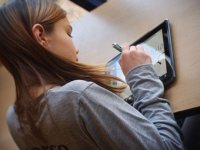How to Roll Out a 1:1 iPad Program
When The Westside School decided to grow its established primary school into a leading middle school program, parents, teachers, students and administrators mapped out an integrated project-based learning environment designed to engage and challenge all participants. The planning team made a list of skills and tools that would support learning, and decided on a 1:1 iPad program to support their vision. I was brought on as technology coordinator to plan and support the curricular and technical deployment for the start of the 2011-12 school year.
After a year or two of early adopter experimentation with education-based iPad deployments, a collaboration of IT departments, edTech consultants and third party vendors pieced together a best practice scenario for iOS management.
Equally as important to successfully implementing a 1:1 program is the social and curricular roll-out to your school community. Our middle school faculty spent two full months intentionally phasing iPads into regular classroom use. Scaffolding student success with iPads went a long way toward building our positive learning community.
Outline of a Phase-In
EdTech Guiding Statement
Provide the opportunity for students to be academically empowered, respectful and responsible with technology, and incrementally successful.
Week 1-2: Personal Academic and Social Success
Classroom lessons didn't involve computers. We focused instead on solid academic habits, community-building, aligning attention, and thinking about intentionality when consulting a tool to assist with learning. Students were asked to consider:
- What is technology?
- How does technology change our world for better and/or worse?
- Is tech good or bad?
Students came to the decision that it is how you use technology that is important, and that the goal of technology is to make life more efficient, productive and rewarding.
Week 2: Families Join In on the Learning
Families were introduced to the devices. Each student, with a guardian, was required to attend a session that covered the school's acceptable use policy, care of devices, warranty/insurance information, etc. Guardians and students were asked to sign a document to confirm their understanding of the opportunities and responsibilities of a one-to-one iPad program.
Week 3: Expose the Potential for Technology
Lessons across disciplines had an element of, "Aw, geez, if only we had a _______ (video camera, web browser, microphone, etc), this would be way easier/better/quicker." Assignments were completed without access to the desired technology, highlighting our dependence on technology.
Students began using iPads in technology class, where they covered the basics of operation, expectations for privacy, and skits or conversations exemplifying main concepts in the acceptable use policy.
Week 4-5: Directed Device Use
Devices were handed out and returned at the beginning and end of each class in which they were to be used. Teachers coordinated to provide lessons that played to iPad features in a variety of contexts. Devices were used as digital books, as calculators, for photography, as a reference, and as a word processor.
Week 6-7: Adapting to Access
After three weeks of demonstrating respect and responsibility with iPads, students started taking the devices with them from class to class. Each student received his or her iPad at morning homeroom and was expected to return it prior to lunch (our afternoons are specialists, PE and arts). Projects and assignments reinforced basic use of the device and introduced some intermediate concepts (exporting files, embedding photos, editing video, etc).
Week 8: Demonstrating Integration
Students were responsible for their iPads all day, storing them in lockers when not in use and taking them home on weeknights. Students were expected to show up for school with the iPad fully charged. iPads stayed at school over the weekend and IT practiced applying updates and backing up the devices.
Week 9: Full Responsibility, Full Trust
Students used the iPads as they saw fit in any class. IT updated and backed up devices approximately once every six weeks during the school day.
Beyond Phase-In
To keep everyone in our community learning, we provided a number of events to support student-device engagement:
- Family support with evening events such as Growing Up Digital
- Periodic celebrations of student work through portfolio reviews and media arts celebrations
- Bi-weekly teacher check-ins during staff meetings
- Spring iPad Open House with local area school IT directors, technology teachers, classroom innovators, administration and curriculum designers
Reflection
Opportunities to be successful went a long way to building confidence and internalizing care of the machines. For kids that were having a tough time at the class-based level or day-based level, there were opportunities to intervene early and provide additional support, before the machines disappeared into backpacks.
Some of the middle weeks were challenging, as teachers were drawn to the potential benefit of iPad access at home. That said, as a team we held firm and asked kids to demonstrate respect and responsibility -- to prove themselves every step of the way. As a result, we have had very few instances of misuse, a surprisingly low number of damaged devices, and an entire middle school, from administrators and students to parents and teachers, that can identify and verbalize the rewards of a 1-to-1 program.
